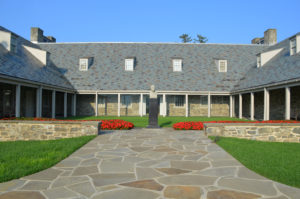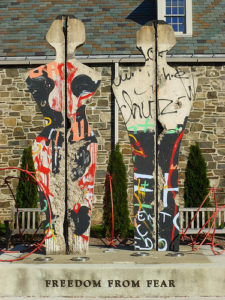The Franklin D. Roosevelt Presidential Library & Museum
Last week, my wife, Rosemary, and I diverted to Hyde Park, New York, on the way back home from Syracuse University to see the Franklin Delano Roosevelt Presidential Library and Museum. The experience was well worth the hour-and-a-half drive south from Albany along the Hudson River and surprisingly relevant. Once you arrive in Hyde Park the main route through town is lined with FDR banners on light poles. The Roosevelt site is on the east bank of the Hudson, high above the river, the views of which have been obscured at the family house level by FDR’s robust conservation and reforestation policy, which the overlook sign text notes as ironic.
Entering the stone Dutch colonial-style library the first big quotation you see high on the wall is this: “The test of our progress is not whether we add more to the abundance of those who have much; it is whether we provide enough for those who have too little.” So much of the New Deal government program displays speak to the current argument about activist vs. laissez-faire public policy—and activist on behalf of the downtrodden and those aspiring to a better life rather than activist in protecting the aristocracy. Maybe it took an aristocrat to say those things, not unlike the Kennedys and old-time Republican Rockefellers in New York and later Democratic Rockefellers in West Virginia. The library, whose public component is a museum with dynamic exhibits about the FDR years, from youth to death, is in a cluster of buildings that includes a modern visitor center and the Roosevelt family home as well as the burial site for Franklin and his wife, Eleanor, so consequential in her own right. There are other buildings on the grounds, such as a hilltop residence that must have a beautiful river view, but we ran out of steam after three hours. The recent Ken Burns film on the Roosevelts had to have been a boost for visitation—there were hundreds of cars on a Friday at 12 noon. All the facilities were top notch, which you want to see at any national park site but especially at a presidential library. We did not go to the sprawling Vanderbilt summer country estate just up the road, another NPS property.
I’m still processing the FDR encounter. In some ways I’m a product of the middle of the 20th century as much as my parents were, mostly because I grew up in a house shaped by their experiences from the 1920s through the ’40s. I showed up in 1954, but really carried their experiences until I was old enough to start adding rings to my own tree that meant something about me.
In the World War II section, Rosemary mentioned that her mother was at Lowell Memorial Auditorium on Sunday, December 7, 1941, when the U.S. Navy ships at Pearl Harbor were attacked by Japanese aerial bombers. The Trapp Family Singers, whose story we know from The Sound of Music and who had left Europe as the Nazis advanced, were on stage in a Moses Greeley Parker Lectures performance. My colleague Dick Howe’s mom was an eight-year-old in the audience and recalls the show being interrupted with an announcement about the attack on Pearl Harbor. I don’t think I’ve ever read an account of that day in Lowell, although in “Atop an Underwood” there is a Kerouac essay about that day, which is called “Search By Night.” In it he describes going for a walk that night, looking at what is going on in the city on that momentous day that changed everything for everyone in Lowell. He has the day’s special-edition newspaper with blaring headlines. There was a special exhibit at the Presidential Library about Pearl Harbor, from lead up through the attack and then the aftermath of conspiracy theories about FDR manipulating the course of history.
The Great Depression section is a clever display using scaffolding to hold up exhibit elements. Every room has a media component, brief and set up in small alcoves that hold about 20 people or on screens that you could stand to look at. There are interactive features like a map that shows Pacific locations the Japanese attacked in the campaign that included Hawaii. There was a reproduction of FDR’s study in the White House, not an Oval Office set up but his private study from what I recall. Around the back of the library is an evocative sculpture of two figures carved from sections of the Berlin Wall after the wall was dismantled. The artwork is a tribute to Roosevelt and Winston Churchill and their partnership during WWII. The Berlin Wall material is a reference to Churchill’s “Iron Curtain” speech in 1946 in Fulton, Kansas, where the matching section of the Wall with figure cut-outs stands. The artist is Churchill’s granddaughter, Edwina Sandys.
Web photo courtesy of timpanogos.com
The grounds are extensive, and the garden around the burial site of Franklin and Eleanor is extraordinary. A hedge of 3.5 -foot-tall zinnias ranging from salmon and lemon to fire-engine red and orange made one side border. Roses had gone by but must have been spectacular early in the summer.
The family home is a country mansion in the style that was popular among wealthy New Yorkers. The place is as it was when the family spent time there, pretty much. Visitors get to see the bedroom in which King George VI and Churchill slept, not at the same time of course.
I had forgotten about the Four Freedoms that became the cornerstone of FDR’s vision after the Axis was defeated. Freedom of speech, freedom to worship, freedom from want, and freedom from fear. This could be Hillary’s campaign outline in 2016 and be as relevant today.
Of course it is not all uplifting in reviewing his political life. Japanese-Americans were rounded up and detained at the start of World War II. Jewish refugee children were turned away at New York harbor (despite Lowell’s congresswoman Edith Nourse Rogers and U.S. Sen. Robert Wagner of N.Y. trying to open the American door to them). FDR bullied the Supreme Court. And other items on the “minus” side of the ledger.
At the dedication of the library in 1941, FDR said, “The dedication of a library is in itself an act of faith…A Nation must believe…in the capacity of its own people to learn from the past that they can gain in judgment in creating their own future.”

